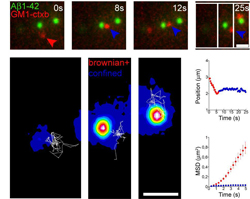Understanding Alzheimer’s disease
Alzheimer’s disease is a neurodegenerative brain disorder associated with clinical dementia. In this disease, amyloid-beta (AB) deposits are believed to cause neuronal deterioration. The dependence of the production of AB peptide on the distribution of the amyloid precursor protein (APP) remains a controversy. The EU-funded project ′Dissecting Alzheimer s disease at a single molecule level′ (SINGLEMOLALZHEIMER) aims to provide a better understanding of the pathogenesis of Alzheimer’s disease at the molecule level. To this end, it employed single molecule tracking techniques to study the interaction of AB oligomers with components of the cell membrane. Although this interaction is well established, the SINGLEMOLALZHEIMER study described the dynamic behaviour of these aggregates on the cell membrane. The surface mobility of the transmembrane proteins involved in AB production, namely APP, alpha-, beta-, and gamma-secretase were studied. Results show a novel mechanism of AB toxicity which is caused by slowly diffusing aggregates. These impact the mobility and function of specific membrane components, thereby leading to cell membrane disruption. A similar mode of action was unravelled for the type II diabetes protein amylin as well as for the prion sup35. This data supported the hypothesis that amyloid diseases share similar mechanisms of toxicity. The clinical extrapolations of the SINGLEMOLALZHEIMER work are undisputed. Delineation of the mechanism of AB toxicity is expected to unravel novel therapeutic targets for the treatment of this severely debilitating disease.







